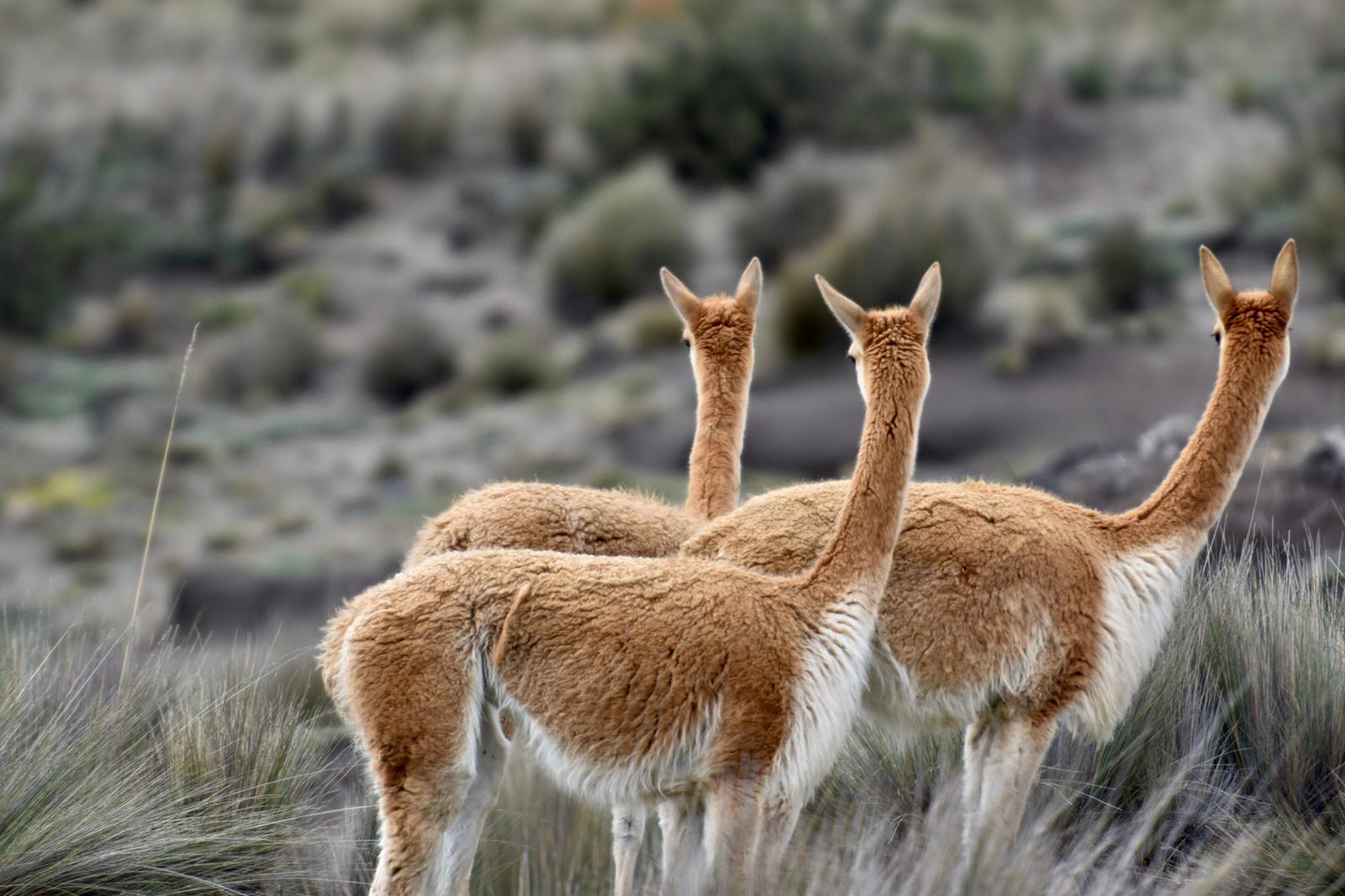The Andes Cordillera is one of the highest mountain ranges in the world; it is common to see peaks over 5,000m in Ecuador. This altitude does not allow for a very developed fauna since few animals can live there and food is less abundant due to climatic conditions. However, some specimens do live there and acclimatise very well. The wildlife that you will see there during your trip to Ecuador will be unique in the world.
Alpaca
The alpaca (Vicugna pacos) is one of the three camelids that you can observe in the Andes Cordillera. Its wool is very famous for making coats.
Its appearance resembles that of a large, soft, multi-coloured plush toy, which will certainly make you fall for it. These animals live in herds.
Size: 75 cm to 1m.
Weight: Ranges from 60 to 80 kilograms.
Aspect: Looks like a big plush. It can have curly and half-long (pictured) fleece if it is of the Huacayo breed, and it can have long, drooping fleece if it is of the Suri breed.
Food: Grass and hay.
Nesting: There is no main period. The female carries the young for 11 months before giving birth; it gives birth once a year.
Lifespan: 20 years.
Population: Around 7,000 in Ecuador.
Where to observe them ?: You will see them in the Cotopaxi and Chimborazo parks.
Vicuña
The vicuna (Vicugna vicugna) also belongs to the camelid family. Like the alpacas, the vicuna lives in the highlands of the Andes mountain range.
Its slender appearance and long neck makes the vicuna a very elegant animal. Its wool is surely the most prestigious in the world.
Size: 75 cm to 1m at the garot, and 1.3 to 1.5 metres at the head.
Weight: Ranges from 40 to 60 kilograms.
Aspect: The vicuna has a long, powerful neck with a slender head, and long, thin legs. Its coat is light brown above and white below.
Food: Feeds on grass.
Nesting: March and April, and the female gives birth to the baby after 11 months of pregnancy.
Lifespan: 20–22 years.
Population: Ranges between 3000 and 4000 in Ecuador. Of Least Concern (LC for IUCN).
Where to observe them ?: You can observe them in the highlands of Chimborazo reserve.
Lama
The llama (Lama glama) is the third species of camelid that you will see in the Andes of Ecuador. It is the most common and best known. The name “Lama” is often incorrectly attributed to its cousins (vicuna and alpaca).
The llama is a domestic animal that is closer to the guanaco than to the alpaca and vicuña which are wild.
Size: Ranges from 1.25 to 1.60 metres.
Weight: Ranges from 80 to 150 kilograms.
Aspect: Its fleece is long and thick. The llama can be brown, white, or black. It has a long neck with a small, thin head.
Food: Feeds on grass, seeds, lichen, and roots.
Nesting: Reproduction takes place from November to May. The female is in gestation for about 12 months.
Lifespan: 15–20 years.
Population: The llama population in Ecuador is unknown, but there are over 3,000,000 samples in Latin America. There is no classification by IUCN.
Where to observe them ?: You can observe them on the high plateaus that range between 2,500 and 4,000 metres.
Paramo Wolf
The paramo wolf (Lycalopex culpaeus reissii) is a subspecies of the Magellanic wolf. This species is endemic to the Ecuadorian Andes.
The Sierra paramo wolf lives on the slopes and high plateaus of nature reserves.
Size: 1.70 metres.
Weight: Ranges from 6 to 13 kilograms.
Aspect: The paramo wolf has a fox-like appearance with light brown colour and a grey back.
Food: Rabbit, birds, and all types of rodents.
Nesting: Reproduction takes place between August and October. The gestation period lasts on average for up to 55–60 days. Females can reproduce every year and give birth to about 3 to 6 pups.
Population: The paramo wolf population in Ecuador is unknown since the species is very wild and shuns all human life. Of Least Concern (LC for IUCN).
Where to observe them ?: You will be able to meet them on the high slopes as soon as you are in the paramo.
Spectacled Bear
The spectacled bear (Tremarctos ornatus) is the only species of bear that lives in South America. The lighter coloured hair that surrounds its eyes gives it this name.
The spectacled bear is a large animal that is mainly a herbivore that eats very little meat. It is a nocturnal animal.
Size: Ranges from1.5 to 1.80 metres with about 80 cm at the withers.
Weight: Ranges from 100 to 180 kilograms.
Aspect: The spectacled bear has black fur with some brown tints. The hair that surrounds his eyes are cream in colour, hence the name “bear with glasses”.
Food: It eats a lot of plants and fruits, and about 5% of its diet is meat. .
Nesting: From April to June; after a gestation period of 6–7 months, the female gives birth to one or two cubs.
Population: The spectacled bear population in Ecuador is unknown, but around 2,000 individuals remain in Latin America. Vulnerable species (VU for IUCN).
Where to observe them ?: You will be able to see them on the high slopes as soon as you are in the paramo.
Hummingbird
The hummingbird (Colibri thalassinus) is an Ecuadorian symbol. This country is considered the land of hummingbirds. Of the 340 known species of hummingbirds, 130 are visible in Ecuador.
Living between 500 and 4,800 metres in altitude, you will be sure to see them during your treks or discovery of remote regions. It has the particularity of being able to flap its wings for up to 9 times per second.
Size: Ranges from 8 to 12 centimetres.
Weight: Ranges from 2 to 22 grams.
Aspect: The hummingbird that lives in Ecuador is mostly green with undertones of blue and purple. Its long, pointed beak makes it easier for the hummingbird to find food from hard-to-reach places.
Food: It feeds on the nectar of flowers and insects.
Nesting: Their nests are the size of a walnut. The females lay two eggs the size of a pea.
Lifespan: 15 years.
Where to observe them ?: You can observe them at altitudes between 500 and 4,800 metres.
Andean Condor
The main symbol of Ecuador, the Andean condor (Vultur gryphus) is present at the top of the country’s coat of arms. This species, which is the most majestic and largest raptor in the world, is present on the heights of the Andes during your stay.
With its 3.2 m wingspan, the Andean condor is the largest land bird in the world. Indeed, only the albatross (sea bird) has a larger wingspan (with its 3.7m).
Size: Ranges from 105 to 130 centimetres.
Weight: Ranges from 9 to 15 kilograms.
Wingspan: Up to 3.5 metres.
Aspect: This raptor has black feathers with a white ruff around the neck. Its head and neck are plucked.
Food: It is a scavenger; it feeds on corpses and carcasses of animals. In the Andes, the condor feeds on corpses of vicuñas, alpacas, or llamas.
Nesting: Condors lay one or two eggs between March and April. The eggs are incubated for 55–60 days.
Lifespan: 50 years, some individuals have lived more than 70 years in captivity.
Population:Where to observe them ?: Living between 3,000 and 5,000 metres above sea level, you will be able to spot it during your treks and walks in the Antisana reserve and at the Zuleta hacienda where you will be (almost) sure to see it.
Peruvian Rock Rooster
With its bright orange crest, the rock rooster (Rupicola peruvianus) will be very recognisable among the many species of birds that you will find in Ecuador.
As its name suggests, the Peruvian rock rooster is the symbol of Peru. This bird is also present in Ecuador in the “cloud forest”.
Size: Approximately 32cm.
Weight: Ranges from 220 to 260 grams.
Aspect: This species is predominantly orange with black wing tips and tail. It is easily recognised by the large orange crest on the top of its skull.
Food: It feeds on fruits and small insects.
Nesting: Between February and July. The female lays two eggs that she will incubate for 28 days.
Population: Almost Least Concern (LC for IUCN).
Where to observe them ?: You will spot them in the Ecuadorian rainforest at altitudes that range between 1,400 and 2,400 metres above sea level. It lives in the region of Baños and Mindo in Ecuador.













